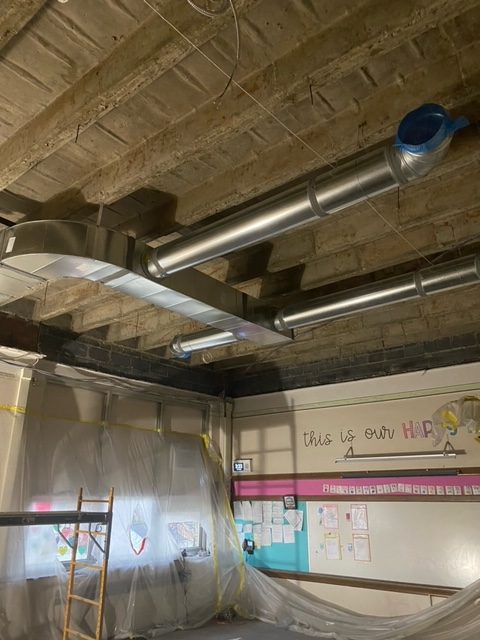Press Release #24/Dec. 6, 2022
Dearborn Public Schools is on track to spend close to $100 million on capital improvements to its buildings over two fiscal years.
That total includes $55 million directly from federal COVID relief funding through ESSERS, the Elementary and Secondary School Emergency Relief fund. The district also was able to use ESSERs funding to offset other allowed expenses, which freed up another $35 million in district funds to invest in capital improvements.
Altogether, the district expects to receive $144 million in ESSER/CARES funds, but much of that money was invested in other areas including $35 million on robust summer school programs, additional social workers to help students struggling emotionally, additional online services for students, and expenses directly related to dealing with the pandemic such as disinfecting supplies and equipment.
The October 2022 Capital Improvement Project report breaks down infrastructure spending by project and funding category. All four CIP reports for 2022 are posted on the district’s website. They can be found on the Transparency page under the ESSER Fund Documents folder.
The largest single project in the district is $17 million set aside to renovate two buildings the district is buying from Henry Ford College. The buildings will house the Henry Ford Early College and allow the district to grow that program. HFEC is a partnership with Henry Ford College and allows students to earn both a high school diploma and associate degree at no cost to the family. About $7 million of the project is coming from ESSERs funding.
However, the largest category of projects is the district’s $40 million investment in air-conditioning tentatively planned for eight elementary schools.
DuVall, Haigh, Howard, Long, Nowlin, Oakman, Snow and Whitmore-Bolles are set to have air-conditioning added as long as bids come in close to initial projections. Lindbergh Elementary may also have air-conditioning added if funding is left after the other projects are bid out. Air conditioning costs are expected to start at about $3.9 million per building, but current inflation for both materials and labor could make those costs higher and force the district to scale back on the air-conditioning work. All of the buildings were designed with radiant heat, meaning a boiler forces hot water through a radiator to warm the building. Because of that, the buildings do not have air ducts or other infrastructure to make it simpler to add air-conditioning.
Preliminary work to install air conditioning has started in several of the schools. Air handling, including air-conditioning, is a permitted expense for ESSER funding. Many other capital improvements, such as roofs, lighting, flooring, parking lots and more, cannot be funded directly from ESSERs.
Other larger capital expenses include:
- $13 million for Haigh Elementary, all from ESSERS funding. In addition to air-conditioning in all or part of the building, the school is getting an addition of classrooms and a new cafeteria and may have the parking lot and playground redesigned. How many rooms will have air-conditioning added will depend on final bid numbers.
- $9 million for professional services including architectural and engineering services to design and help bid various projects.
- $6.1 million for Whitmore Bolles from ESSERs for air conditioning and related work.
- $5.5 million for Snow Elementary from ESSERs for air conditioning.
- $4.5 million at Lindbergh Elementary, including $2 million from ESSERS. Most of this will be for air conditioning, if funding is left after the bids on the other projects.
- $4.2 million for Duvall Elementary, mostly from ESSERs funds, for air conditioning. About $238,000 in district funds were used for playground and parking areas.
- $4 million for Long Elementary all from ESSERs for air conditioning.
- $4 million for Nowlin Elementary mostly from ESSERS for air-conditioning. Nowlin also had its gym floor replaced using $63,900 in district funding.
- $4 million for Oakman Elementary from ESSERs for air conditioning.
- $3.9 million for Howard Elementary from ESSERs for air conditioning.
- $3 million for Food Service for the addition of walk-in freezers. Food Service operates from a separate budget funded by food sales, including reimbursements from the National School Lunch Program.
- $1.4 million in district funds to revamp the pool and natatorium at Edsel Ford High, including new pool equipment, ceiling and lights. Work at the school also includes adding a new floor in the main gym and weight room.
- $1.5 million for safety and security upgrades paid for from state grants.
- $1.2 million from ESSERs for O.L. Smith Middle to replace boilers, improve exhaust fans and upgrade mechanical controls.
- $883,670 for Fordson High to replace the slate roof on the original section of the building and to add air conditioning in the auditorium.
Dearborn Public Schools has 37 buildings serving more than 20,000 students. Excluding ESSERs funding, the district’s annual total budget is about $395 million a year.
“ESSER funding, both directly and indirectly, has allowed us to invest far more than we normally could into our buildings over just a couple years. We are grateful for that opportunity,” said TomWall, Executive Director of Business Services and Operations. “However, ESSER funding will be committed by September 2024, and we will still have lots of infrastructure work that needs to be done. We have been able to increase our annual budget for infrastructure work to $14 million, but at least $10 million will be redirected for staffing costs that are currently supported by ESSER funds. We most likely will not be able to fully maintain and update all of our buildings with our current operational funds.”

